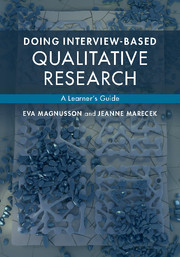Book contents
- Frontmatter
- Contents
- 1 Introduction
- 2 Some examples of interpretative research
- 3 Planning and beginning an interpretative research project
- 4 Making decisions about participants
- 5 Designing the interview guide
- 6 Doing the interview
- 7 Preparing for analysis
- 8 Finding meanings in people's talk
- 9 Analyzing stories in interviews
- 10 Analyzing talk-as-action
- 11 Analyzing for implicit cultural meanings
- 12 Reporting your project
- Epilogue
- References
- Index
6 - Doing the interview
Published online by Cambridge University Press: 05 October 2015
- Frontmatter
- Contents
- 1 Introduction
- 2 Some examples of interpretative research
- 3 Planning and beginning an interpretative research project
- 4 Making decisions about participants
- 5 Designing the interview guide
- 6 Doing the interview
- 7 Preparing for analysis
- 8 Finding meanings in people's talk
- 9 Analyzing stories in interviews
- 10 Analyzing talk-as-action
- 11 Analyzing for implicit cultural meanings
- 12 Reporting your project
- Epilogue
- References
- Index
Summary
Research interviews are not ordinary conversations. The interviewer is there to learn something from the participant; therefore, the focus is on the participant, and the participant does most of the talking. The questions in the interview guide govern the content of the interview. The interviewer asks those questions and also manages the interaction throughout the conversation. The interviewer is responsible for ensuring that the conversation flows smoothly and that the participant feels comfortable.
In this chapter, you will learn the principles and practices for conducting face-to-face interviews. The chapter focuses on the interviewing craft: what experienced interviewers do in typical interview situations and what they can do when problems arise. We begin the chapter with an overview of the sequence of an interview. Then we describe techniques for guiding an interview and maintaining its structure. This is followed by a section about complicated situations that sometimes occur during interviews and how the interviewer can resolve them. We then discuss what it is like to be an interviewer in a research interview. We also discuss the relationship between interviewer and participant. Finally, we give advice on how to conduct pretests and pilot tests of your interview guide.
An overview of the research interview
This section is an overview of the interviewer's main activities during the successive phases of a research interview. The purpose is to give an overall sense of the flow of an interview; we will describe complications later.
The preliminaries
Most of the preliminary decisions will be made before you enter the interview situation. You will have made the decisions regarding the participants, which we described in Chapter 4 – for example, whom to interview, how to reach and recruit participants, and where to hold the interviews. You will also have composed the interview guide, as we described in Chapter 5.
Information
- Type
- Chapter
- Information
- Doing Interview-based Qualitative ResearchA Learner's Guide, pp. 58 - 72Publisher: Cambridge University PressPrint publication year: 2015
